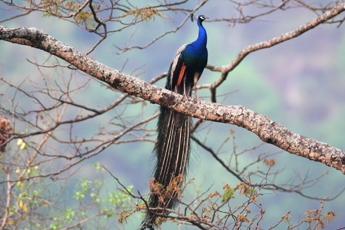15 birding days
A Far-eastern Odyssey ... Japan is seldom seen on birding tour itineraries, which is strange, as it has excellent birding throughout the island chain. Winter is a good time to visit, with famous gatherings of Cranes and Steller's Sea Eagles, and we will visit five islands, from the frozen north to the subtropical south in search of the specialties and endemics.
{backbutton}
Fact File
- 15 birding days in Japan visiting five islands for endemic and rare birds
- start and finish in Tokyo
- using accommodations close to the sites
- internal flights between islands
- ferry from Tomakomai to Oarai
Highlights
- visiting the subtropical Amami and Okinawa islands
- exploring the Arasaki Reserve for 6 species of wintering cranes
- birding at highland lakes and in the woodland at Mi-ike
- visit to Kushiro, wintering site of Steller's Sea Eagles
- pelagic birding on a ferry
- many specialties and endemics
Price
Ask for the actual price.
Our price includes:
- all travel within the country as noted in the itinerary;
- all accommodation based on shared rooms (most rooms are twin bedded), at most locations there are single rooms as well for extra charge (Please ask for a single room at the time of booking!);
- 3 meals per day, generally breakfast at the accommodation, packed lunch, dinner (consists of at least two courses);
- services of the leader(s);
- trip materials.
Not included:
- optional programmes to places of interest and its entrance fees,
- passports and visas,
- airport and other departure taxes, tips,
- food beyond generally 3 meals/day mentioned in the itineraries,
- camera charges in national parks,
- immunizations,
- excess baggage charges,
- telephone calls,
- alcoholic beverages,
- compulsory personal insurance.
If you have questions about the inclusion of any cost item, please contact us.
Activity level
Generally easy walks
Warm weather with some rain in the south, cold weather with snow in the north
Itinerary

1-15
After arrival in Tokyo, we transfer to the domestic airport, from where we take a flight south, to visit the southern sub-tropical islands of Amami and Okinawa, part of the Ryukyu Chain. These islands have several endemic species which we hope to catch up with, including the stunning Ryukyu Robin, Lidth's Jay, Amami Thrush, Amami Woodcock, Ryukyu Minivet, and Okinawa Woodpecker. After dark, we will look for the nocturnal Ryukyu Scops Owl and scarce Okinawa Rail. Other species include Japanese Sparrowhawk, Red-capped Green Pigeon, Japanese Woodpigeon, Pacific Swallow, Black-backed Wagtail, White-eared Bulbul, Olive-backed Pipit, Chinese Bulbul, Red-flanked Bluetail, Dusky Thrush, Stub-tailed Bush and Japanese Bush Warblers, Varied Tit and Japanese White-eye. We will have time to look over mudflats, for a mixture of shorebirds, including Grey-tailed Tattler, Greater and Mongolian Sand Plovers, Swinhoe's Snipe, Red-necked Stint, and rarities have included Spoon-billed Sandpiper and Far-eastern Curlew.
After the Ryukyus, we will fly to Kagoshima, on the island of Kyushu. Here, one of the highlights will undoubtedly be the Arasaki reserve, where there is the possibility of six species of crane in a spectacular gathering, including over 8000 Hooded and 2000 White-naped! Others often present in smaller numbers include Common, Sandhill and Demoiselle. The whole area is excellent, and we hope to find Black-faced Spoonbill, Japanese Skylark, Brown-eared Bulbul, Brown Dipper, Chinese Penduline Tit, Pale, White's and Brown Thrushes, Bull-headed Shrike, Oriental Greenfinch, White-cheeked Starling, Chinese and Japanese Grosbeaks, Russet Sparrow, Grey-headed, Rustic, Meadow and Yellow-throated Buntings and Daurian Jackdaw. Other areas we will visit include Yatsushiro, where mudflats will be filled with eastern waders, Saunder's and Vega Gulls are regular, and Falcated Duck can be found at sea. Dams and rivers nearby hold Mandarin Duck, Long-billed Plover and Crested Kingfisher.
The highland lakes and surrounding woodland at Mi-ike provides the opportunity to look for Baikal Teal, as well as Ryukyu Minivet. Other species likely to be seen include Varied Tit, Japanese Waxwing, Japanese Grosbeak, Japanese Pygmy and Japanese Green Woodpeckers. Luck may also bring us the endemic Copper Pheasant and Grey Bunting. We finally spend some time on the east coast, where we should be able to track down Japanese Murrelet.
Departing from Oita, we fly to Kushiro via Tokyo. Here, on the northern island of Hokkaido, the weather becomes very cold, and pack-ice may have formed on the sea. We will be staying in the east of the island, and our main quarries will be the winter gatherings of Steller's and White-tailed Sea Eagles, and Red-crowned Cranes. The sight of the eagles on the ice-covered sea, and the cranes dancing in the snow will be treasured memories.
In addition to these, we will look around the peninsula and Lake Furen for wintering ducks and alcids, which may include Harlequin Duck, Steller's Eider, Pelagic and Red-faced Cormorants, Long-billed and Ancient Murrelets, and Spectacled and Brünnich's Guillemots. Other species we will seek out on the island include Brown Dipper, Asian Rosy Finch, Gyr Falcon, five species of woodpecker, Japanese Wagtail and we have a good opportunity of finding the rare Blakiston's Fish Owl in the gardens of our Japanese inn at Rausu.
From Kushiro, we set off by train to the ferryport at Tomakomai, from where our journey will be on a warm comfortable ferry, although we will need to wrap up well to keep out the icy cold whilst on deck. The next morning will be a pelagic which will allow us to look for many seabirds, and these can include Laysan, Black-footed and maybe Short-tailed Albatrosses, Pacific Diver, Sooty, Streaked and Short- tailed Shearwaters, Tristram's Storm-petrel, South Polar Skua, Black-tailed, Glaucous, Glaucous-winged and Slaty-backed Gulls and Black-legged Kittiwake. When we arrive at the ferryport at Oarai, we will take a short train journey before driving back to Tokyo via some wetlands, where we may find Brown Thrush, Daurian Redstart, Red-flanked Bluetail, Asian Marsh Harrier and Painted Snipe.



























